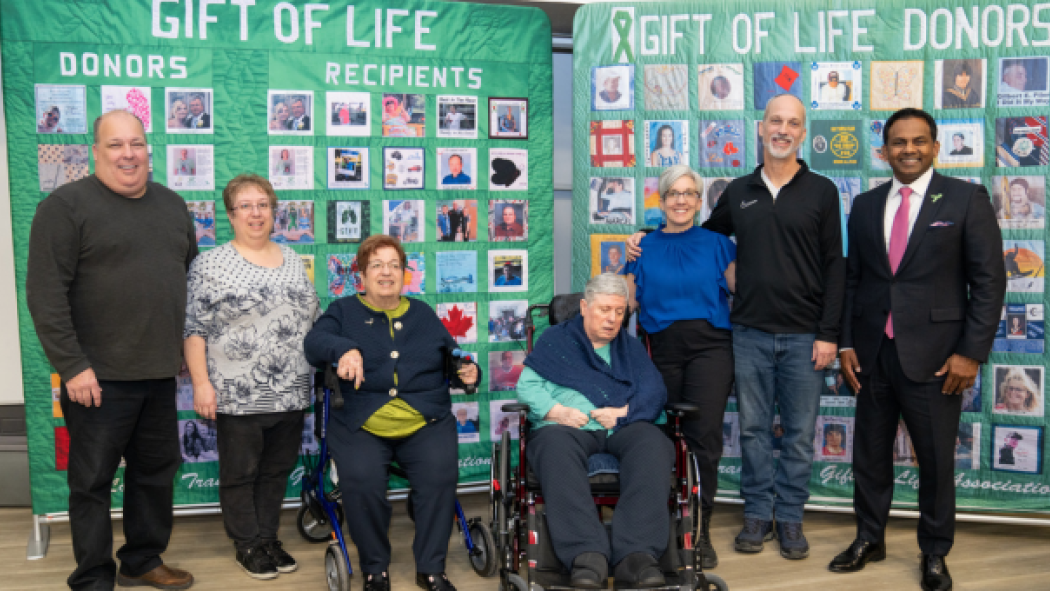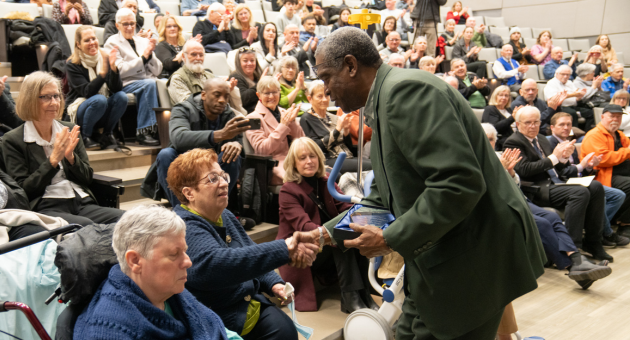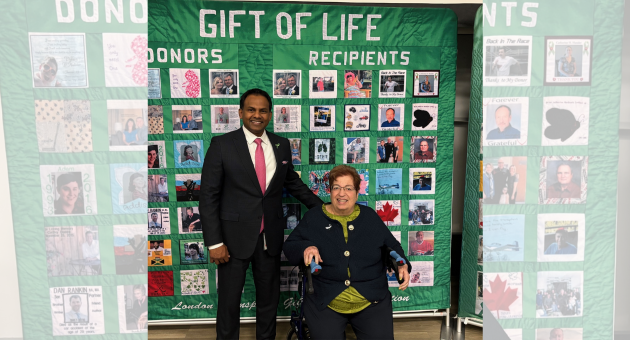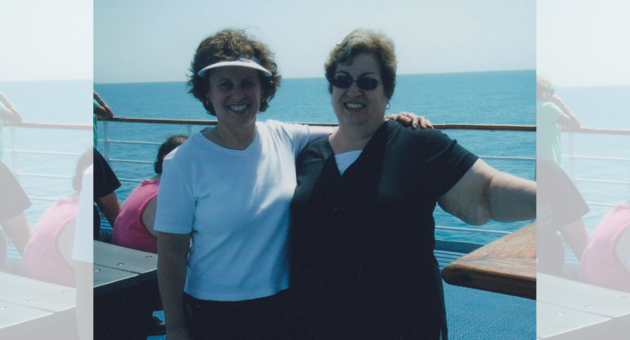
LHSC Medical Co-Director, Multi-Organ Transplant Program, Dr. Lakshman Gunaratnam (far right), is pictured with sisters (middle) Mary Ann Crossett and Margaret Reardon and family as they mark their 50th anniversary of a living kidney donation
November 19, 2025
In 1975, London Health Sciences Centre (LHSC) introduced living donation as part of its transplant program offering. For one close-knit family, this made possible a remarkable gift in the form of a living kidney donation from one sister to another.
Mary Ann Crossett’s kidney issues began silently. Though she had never felt sick, at age 16 a routine urine test at her family doctor’s office revealed abnormal protein levels. She would go on to learn that over time, blocked urine flow from an undetected birth defect had quietly caused chronic nephritis, an inflammation of the kidneys. She underwent surgery to have her ureters, the tubes connecting the kidneys to the bladder, re-implanted.
Despite the surgery, over the next few years, Mary Ann’s condition worsened, especially after having two children in quick succession. By the end of 1974, her kidneys had completely shut down. She began dialysis in early 1975, enduring long drives to London from Aylmer and six-hour sessions that left her exhausted, while often getting up early the next morning to teach.
“You never feel well while on dialysis,” says Mary Ann. “It keeps you alive, but just barely.”
That summer she was placed on the organ transplant waiting list. While living transplants were possible at the time, they were not yet common, and she was cautioned not to ask her siblings to donate as it could put undue pressure on them. There were much greater risks for both the donor and recipient in those early decades of transplantation than there is today with advancements in both surgical techniques and anti-rejection medications. Never so grateful to have five brothers and sisters, Mary Ann promptly ignored this advice and asked each of them if they’d consider donating a kidney.
When one of her brothers wasn’t a match, her younger sister Margaret Reardon volunteered to be tested next. When the results came back, everyone was astounded because it was almost a perfect match – one that could only have been better if they had been identical twins.
It was November 19, 1975, when Margaret donated one of her kidneys to Mary Ann. This became a gift that not only changed the course of Mary Ann’s life but one that cemented a special bond between sisters that time and illness could never shake. That day, both sisters underwent successful surgeries at LHSC’s University Hospital.
For Mary Ann, she recalls her healing as swift, both physically and emotionally.
“I felt so good, even right after the surgery,” she says. “My mom couldn't believe she was seeing pink in my skin instead of that yellow tone I’d had for years. I was fully alive again.”
Mary Ann returned to teaching just months after the transplant and rarely missed work in the years that followed. She retired in 2006 after a prestigious 35-year teaching career. While her husband, Brian, sadly passed away in 1997, her two children, five granddaughters, and four great grandsons continue to fill her life with joy. Like all transplant recipients, she still takes anti-rejection medication, but her health has been excellent.
Margaret too recovered from the surgery and has enjoyed decades of good health with her family which includes her two children and two grandchildren. Despite having developed early onset Alzheimer's disease, the unbreakable bond and closeness formed with her sister all those years ago endures.
Today, Mary Ann and Margaret celebrate an incredible milestone that few living transplant pairs have reached: their 50th transplant anniversary. What began as a hopeful gesture between two young sisters has become a lifelong legacy of resilience, gratitude, and unwavering family support.
“We were both so young, her just 21 and me 25, each with young families at the time,” says Mary Ann. “Over the years we have looked back and joked that we don’t know what we were thinking! At the heart of it, we just knew I needed a kidney, and without hesitation my sister was there. Now 50 years later, it is easier than ever to say, she has given me the gift of life, and there is no better gift that anyone could ever give.”
The milestone also serves as a testament to the pioneering legacy of transplantation at LHSC and the half century of care that has changed the lives of countless patients and families.
“We were very much on the forefront of care fifty years ago, and I’m proud that our program continues to carry that same spirit of innovation half a century later,” says Dr. Lakshman Gunaratnam, Medical Co-Director, Multi-Organ Transplant Program at LHSC. “While it is easy to mark a big anniversary like this in years, it is much greater than that. There is so much significance that can’t be measured in the years we have been able to give to the lives of patients like Mary Ann because of the generosity of living donors like Margaret. It’s that intangibility that motivates and excites us to continue to make advancements in this field of life-saving care.”
LHSC living transplant stats at-a-glance
- 857 living donor kidney transplants completed to date
- 60 living donor liver transplants completed to date
- Performed Canada’s first living-related liver transplant (mother to son) in 1993
- Performed Canada’s first adult-to-adult living liver transplant in 2000
The National Kidney Paired Donation (KPD) Program was established in 2009 by Canadian Blood Services. Our LHSC team has worked closely with our Canadian neighbours to expand opportunities for living kidney donors and recipients across the country.
Photo Album

Carl Cadogan, Senior Regional Manager, Southwestern Ontario, Kidney Foundation of Canada presented the sisters with a commemorative plaque for the anniversary

Dr. Gunaratnam and recipient Mary Ann Crossett are pictured at the celebration event.

From the family photo album: Sisters Mary Ann and Margaret

From the family photo album: Sisters Mary Ann and Margaret
